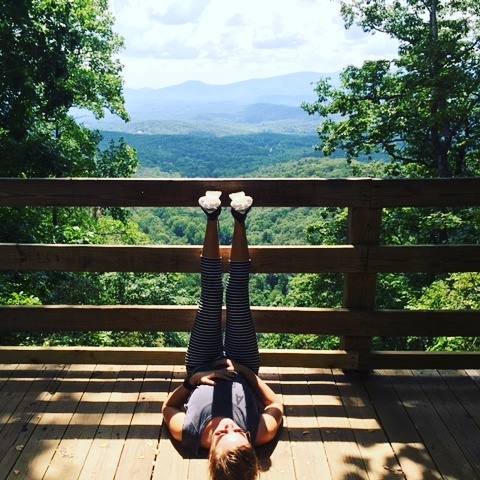
our wisdom
Trauma Informed Yoga for Self-Regulation
Trauma informed yoga for self-regulation
Self-regulation refers to our ability to manage and control our thoughts, emotions, and behaviors in response to different situations. It involves maintaining a sense of equilibrium, even amidst external stressors or internal challenges. Self-regulation empowers us to navigate through life's ups and downs with composure, resilience, and adaptability.
Yoga practice can be the most accessible tool that we can use to self-regulate.
Check out a 30-minute yoga practice with me that can serve as a helpful tool amidst chaotic time.
Trauma-informed yoga for self-regulation.
Discover the Deep Relaxation and Healing Benefits of Yoga Nidra
Yoga Nidra is a guided meditation technique that promotes deep relaxation and stress reduction. Scientific studies have shown that regular practice of yoga nidra can improve overall well-being, cognitive function, and immune system function, as well as treat conditions such as PTSD and chronic pain. This post explores the benefits of yoga nidra and provides tips on how to practice it effectively.
Yoga Nidra is a form of guided relaxation and meditation that is often referred to as "yogic sleep." It is a technique that allows the body and mind to completely relax while remaining conscious and aware.
During a Yoga Nidra practice, participants lie down comfortably and follow the guidance of a facilitator. Yoga Nidra facilitator will lead everyone through a series of visualizations and body awareness exercises, breathwork, visualization, and relaxation techniques, designed to induce a state of deep relaxation and heightened awareness.
Yoga nidra practice has been scientifically proven to have many benefits for both physical and mental health. Studies have shown that regular practice of yoga nidra can reduce stress, anxiety, depression, and insomnia, as well as improve overall well-being, cognitive function, and immune system function. Additionally, yoga nidra has been used as a therapeutic tool to treat conditions such as PTSD, chronic pain, and substance abuse.
If you are interested in giving Yoga Nidra practice a go click here to experience a 10-minute Yoga Nidra To Reset The Nervous System.
Here are some sources for the benefits of yoga nidra studies:
Yoga Nidra as a Therapeutic Intervention for Military Veterans with PTSD: A Randomized Controlled Trial. Journal of Clinical Psychology, 2014. https://onlinelibrary.wiley.com/doi/abs/10.1002/jclp.22081
Yoga Nidra relaxation increases heart rate variability and is unaffected by a prior bout of Hatha yoga. Journal of Alternative and Complementary Medicine, 2011. https://www.ncbi.nlm.nih.gov/pmc/articles/PMC3151418/
Exploring the Therapeutic Effects of Yoga Nidra on Chronic Pain: A Clinical Case Series. International Journal of Yoga Therapy, 2018. https://www.ncbi.nlm.nih.gov/pmc/articles/PMC6390488/
Effect of Yoga Nidra on Blood Glucose Level in Diabetic Patients. International Journal of Yoga, 2013. https://www.ncbi.nlm.nih.gov/pmc/articles/PMC3887506/
Effects of yoga nidra on psychological general well-being in patients with menstrual disorders: a randomized controlled trial. International Journal of Yoga, 2021. https://pubmed.ncbi.nlm.nih.gov/34084363/
Irina
Legs Up the Wall: The Ultimate Relaxation Posture
If you practice one yoga posture a day practice this one
Have you heard of Legs Up the Wall (Viparita Karani) pose? It's a restorative yoga posture that can bring about deep relaxation and help with stress relief. Even better, this pose has amazing benefits for your lower back health! Let's take a look at what Viparita Karani is all about.
What is Legs Up the Wall?
Legs Up the Wall (Viparita Karani) is a gentle inversion pose that helps to relieve stress and promote relaxation. To practice this pose, you will need something to prop up your legs (like a wall or chair) and a yoga mat or blanket for support. Once you are ready, lie on your back and place your legs against the wall, making sure that your hips are close to the wall. You can also place a cushion or bolster under your hips for added comfort. Relax into this posture for at least five minutes and breathe comfortably. This quick practice will help to reduce stress, calm your mind, and improve circulation throughout your body.
Lower Back Health Benefits of Viparita Karani
This restorative yoga posture can also be beneficial for lower back health as it helps to stretch out tight muscles surrounding the back area. By stretching out these muscles, Viparita Karani can help to alleviate lower back pain and tension while promoting blood flow in the area. It can also help improve flexibility in your hips and spine which can further reduce lower back discomfort over time.
Viparita Karani is an incredibly versatile pose that offers numerous benefits both physically and mentally! Not only does it promote relaxation by calming the mind, but it can also provide relief from lower back pain while improving overall flexibility in the hips and spine. So if you’re looking for an easy way to unwind after a long day or just want to take some time for self-care, don’t forget about Legs Up the Wall! Give it a try today!
A Guide to Restorative Yoga for Stress Reduction
The most obvious benefit of restorative yoga is its ability to reduce stress and tension in the body. It can help lower cortisol levels—the hormone associated with stress—which can have a positive effect on overall health and wellbeing.
Stress, anxiety, and tension are all-too-common experiences in our modern lives. We’re constantly being pulled in different directions and pushed to our limits. But there is hope! Restorative yoga is a great way to reduce stress and promote relaxation. Let's explore why restorative yoga is so beneficial for stress reduction.
What Is Restorative Yoga?
Restorative yoga is a type of yoga practice that helps your body relax deeply, using props such as blankets, bolsters, and blocks to support your body in various poses. This allows you to stay in the pose longer while still being comfortable, allowing you to stretch more deeply than if you were just holding the pose on your own. The use of props also makes it easier to relax into the poses, which helps you let go of any tension or stress that might be stored in your body.
The Benefits of Restorative Yoga
The most obvious benefit of restorative yoga is its ability to reduce stress and tension in the body. It can help lower cortisol levels—the hormone associated with stress—which can have a positive effect on overall health and wellbeing. Additionally, restorative yoga can help improve sleep quality by relaxing the mind and calming racing thoughts that often occur at night when trying to fall asleep. Finally, restorative yoga can help increase flexibility by stretching out tight muscles and connective tissues over time.
Creating a Restorative Practice
Creating a successful restorative practice takes some planning but is totally doable! Start by finding a comfortable place where you won't be disturbed for at least 15 minutes; this could be your bedroom or living room or even outside under a tree if weather permits! Set up your space with all the props you need for each pose; blocks for support under hands or feet, blankets for extra cushioning on joints like knees or elbows, straps for stretching arms behind the back, etc… Once everything is set up it's time to start moving! Use slow movements—like standing up from one pose (like mountain pose) then slowly bowing forward into downward facing dog before transitioning into child's pose—to get into each position while focusing on breathing deeply into each movement. Stay in each position anywhere from 5-15 minutes depending on what feels right for your body before slowly transitioning out of each posture back into mountain pose then finally lying down onto the floor with legs stretched out wide open palms facing up towards ceiling staying here until end of practice.
Restorative yoga can provide great relief from both physical and mental tension & stress allowing us to gain control over our bodies & minds so we can live more happily & healthily no matter how stressful life may seem at times. With proper preparation & practice we can create successful restorative practices that will make us feel relaxed & rejuvenated every single time we move through them! So take some time today—even if it’s just 5 minutes—to practice restorative poses & start feeling better today!
STAYING CENTERED AMID CHAOS
In yoga teaching we have a saying that “we hold our issues in our tissues” meaning that we store stress in our physical bodies. Think about how you physically feel when you watch the news. Do you clench your jaw, tighten up in your chest and shoulders, or experience irregular breathing? If you are not constantly mindful about coping with stress and fear, it is very easy to store them long term. This in turn can cause harm to both your mental and physical health.
At the moment we are being flooded with news of the rapid spread of coronavirus and all of the possible outcomes because of it. I encourage you to focus on what you can control. We already know that you are washing your hands and staying away from big crowds. Now let’s find some coping mechanisms and create an on-demand de-stress toolbox.
Due to the rapid spread of the virus we are encouraged to self-quarantine and to stay away from other people. However the beauty of being here and now is the variety of online resources readily available.
Yoga – If you are looking to start your yoga practice and feel too intimidated to walk into a studio, check out resources on platforms like YouTube where you will find many options for your practice. Some of my favorite beginner-friendly yoga channels are Yoga With Adriene, Body Positive Yoga, Faith Hunter, and Heart Alchemy Yoga. All you will need are a yoga mat or a beach towel, blocks or a stack of books and you are ready to practice. Yoga is not only a great tool to feel connected to your body and your mind but according to The Journal of Behavioral Medicine it can also boost your immune system. Next time you feel stress and fear flooding in, unroll your mat and melt them away with a yoga practice.
Breathing Exercises – Another helpful and easily accessible tool for de-stressing is your own breath. Try the following breathing technique. Sit comfortably in a chair and begin to breathe in through your nose for four counts, inhale and hold your breath in for four, exhale for four and hold the breath (empty lungs) out for four. Repeat this for 1-2 minutes. This breathing technique is called box breathing. According to Medical News Today it is used by Navy SEALs, police officers and nurses to decrease stress and promote mindfulness.
Meditation – I also encourage everyone to check out the following meditation apps: Calm, Headspace and Breethe. To benefit from meditation you need to be consistent at practicing it. So, invite your loved ones to participate in a mindfulness challenge. Encourage them to practice meditation at least 10 minutes a day and see how awesome you all will feel afterwards!
I hope that you will stay healthy and stress-free and remember “this too shall pass.”
May 21, 2020









